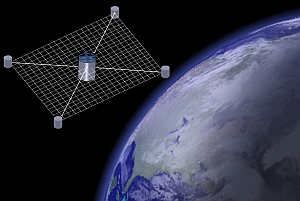Students in a spin after ESA commission space-web
Published: 7 April 2009
It is not often students see the final results of their projects launched into orbit but that’s exactly what will happen for six Glasgow students.
They are aiming for the stars after being commissioned by the European Space Agency (ESA), along with two colleagues from KTH Royal Institute of Technology in Sweden, to construct a space-web to be launched onboard a rocket in March 2010.
The space-web is a flexible structure made from a high performance polymer – an ultra-light, ultra-strong fibre used in a variety of applications including fishing lines – which will be deployed once the rocket reaches orbit.
It is hoped space webs can act as lightweight platforms for the construction of large structures in space without the huge costs of launching heavy materials from Earth. Huge satellites to harness the Sun's energy, or antennas for further exploration of the universe, may be constructed by miniature robots which crawl around the web.
The space web is deployed and kept rigid by exploiting the centrifugal forces experienced by spinning the web structure: the same force experienced when a car goes round a sharp bend or on some fairground attractions.
The team of PhD students that will construct the space-web, with the aid of a grant from the ESA, is an international group: Christopher Murray, from Scotland, specialising in mathematics & physics; Yi Chen, from China, control engineering; Norilmi Ismail, Malaysia, mechanical engineering; Christy Maddock, Canada, telecommunications; Malcolm McRobb & Andrew Mathieson, Scotland, mechanical engineering – and they have just one year to prepare for its launch from Esrange in northern Sweden.

The project is part of an ESA programme of experiments for university students conducted on rockets and balloons. The team had to present their proposal to a panel of experts from the ESA, Swedish National Space Board, Swedish Space Corporation and German Aerospace Centre.
Chris Murray said: “This is certainly a great opportunity for all of us. We will have 30 seconds to deploy and stabilise the web so we need to make sure it works first time as there can be no second chance. If we are successful it will give us the greenlight to develop our work further.
“We are confident that we can make this work and meet the tight deadline and I think we put that across to the panel when the selections were made. We’re giving it everything we’ve got.”
The team will be able to call on support from Matthew Cartmell, James Watt Professor of Mechanical Engineering at the University of Glasgow and the UK’s leading authority on space tethers; and Dr Max Vasile, also at the University of Glasgow, a highly experienced space systems engineer. The group is also receiving technical support and hardware from Glasgow-based small satellite company Clyde Space.
For more information contact Stuart Forsyth in the University of Glasgow Media Relations Office on 0141 330 4831 or email s.forsyth@admin.gla.ac.uk
First published: 7 April 2009
<< April

